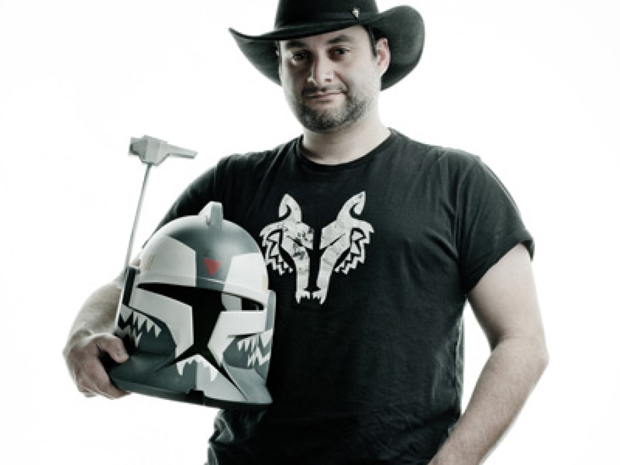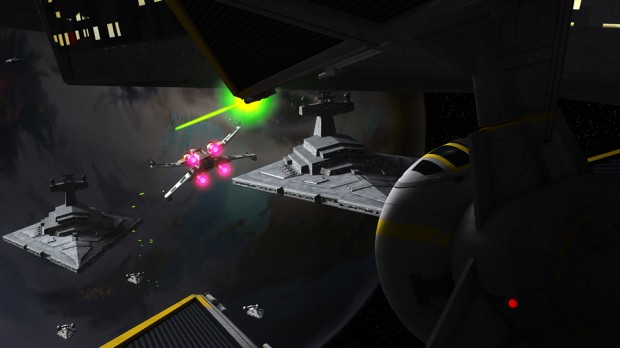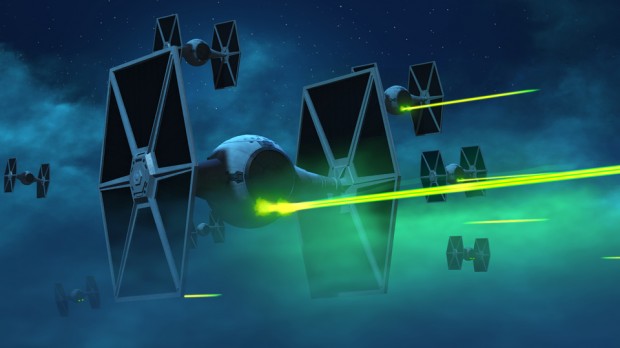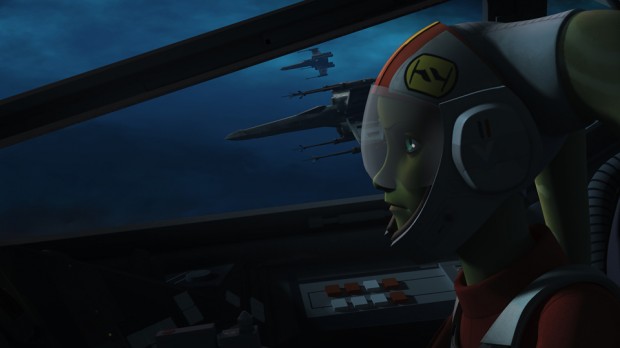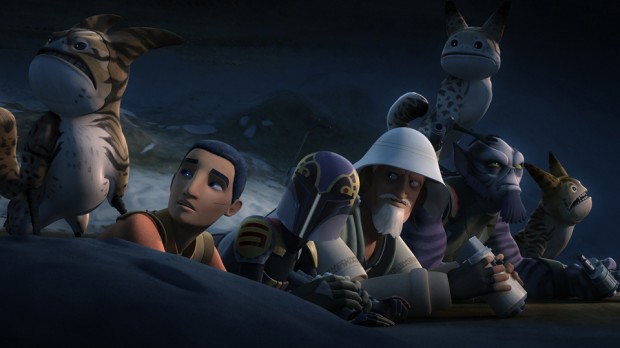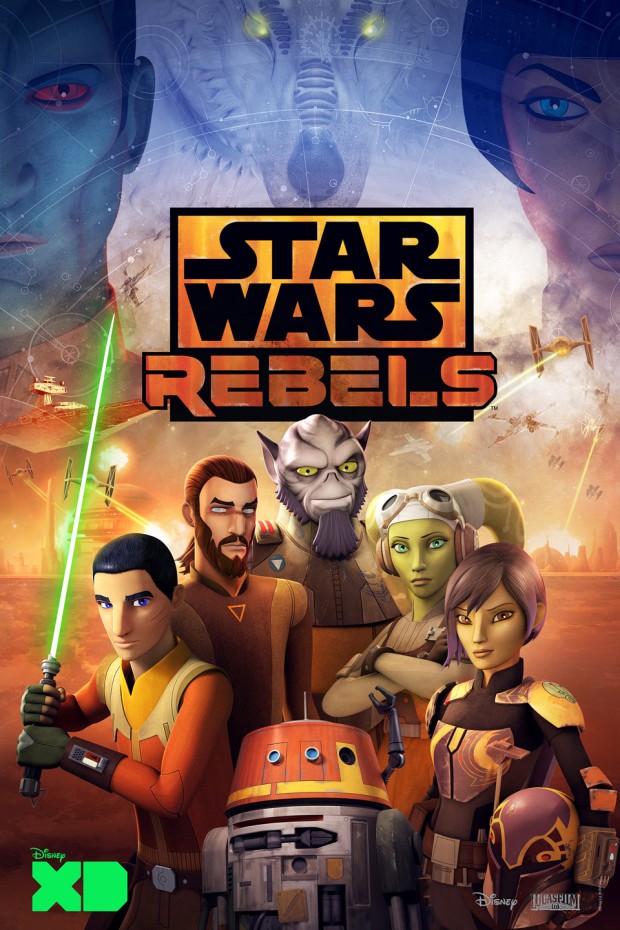Dave Filoni has probably overseen more hours of Star Wars content than anyone outside of George Lucas himself. The Star Wars Rebels finale event currently airing over a course of three weeks marks over 200 episodes (and one feature film) made under his watch at Lucasfilm Animation since the start of Clone Wars in 2008. I had a chance to speak with Filoni about his feelings and production process with this closing of a chapter in Star Wars history.
He’s someone with an exuberant passion for both Star Wars and the collaborative process of animation. It’s abundantly clear why both George Lucas and Disney have put their trust in him to continue telling stories in the Star Wars universe.
Now that Star Wars Rebels is wrapping up, are you satisfied with the way it’s closing?
Filoni: I’m pretty satisfied. This is the first time I’ve been able to draw a series to a close in this manner. We had worked on different ways Clone Wars could end, but there’s a difference between having theories about how you would do something and actually executing it. These last six episodes I think are among our best, which they should be. If we went back to the beginning, there are some things we would change and improve a bit, but all in all I’m pretty pleased with it. We didn’t really leave much on the table either. There are always other stories you can tell, but I think for the story of Ezra Bridger it’s come through in a way that I’m happy with.
You really defined the Mandalorian culture this season. How much if any of that was influenced by prior extended universe depictions of Mandalorians?
Filoni: For the most part, the Mandalorians that we see in Rebels are just an extension of the ones I was working on in Clone Wars. A lot of that was in conjunction with working directly with George, and he layed out what he thought the civilization was like at the time of the Clone Wars. When we built it back then, I took a lot of the extended material and tried to parcel out a greater timeline that would include what was happening in [Knights of the Old Republic]’s time, and then thousands of years later they would become a different type of society. Just because these people were one thing thousands of years ago doesn’t mean they’re gonna be that now. If you look at our own world that’s very true — people change and evolve, societies and empires rise and collapse.
So, I expanded what Mandalorian society would be under the Empire. Sabine’s story becomes one about family, and her family is one that was affected and shattered by the Imperial involvement in her society, and how her family tried to protect her but she was confused by it and felt ostracized. All those things that you build in your mythology parallels how kids feel in real life. The way teenagers can feel ostracized and like outsiders when the elements come into their world. That’s why Luke’s journey is familiar to us and Han’s journey is familiar to us. We all have similar experiences, though probably not in the Millennium Falcon.
One major theme in Rebels has been the different ideas of different subsets of the rebellion of how to fight the Empire. Is any of it reflective of your own views on the morality of Star Wars or the wider world?
Filoni: I think what’s interesting is how broad it gets. It starts fundamentally as good vs. evil, but as you get drawn into the more complex world that the prequels offer, there are more politics involved and there are many sides involved, and I personally think it makes it very real. It’s not so much about obvious evil that walks into your world as much as it is the root of the tree rotting from inside and something beautiful that falls apart, which is often how things go in the real world. You do have a history of democracies that collapse and fall into becoming dictatorships. You have forces even when they’re on the same side who debate what is the best way to go about winning this fight. Do we try to use diplomacy, and if we use violence what are the consequences? Everybody at the end of the day, even without the Empire, becomes a pawn of evil and the machinations of Palpatine.
Luke’s whole message — and I think the message of Star Wars — is not to be of yourself but to be selfless, to find some sense of enlightenment and to inspire others to great action as well. So I try to work from those same themes throughout Rebels and show that there aren’t all these simple answers, but there is still good and evil and different ways to battle.
Did you conceive these last few episodes with an idea of what NOT to do when ending a TV series?
Filoni: We were always pretty resolute from the beginning that we weren’t trying to set up one of the other films. The end of our series wasn’t going to be the beginning of A New Hope or the beginning of Rogue One. Early on there was thought that it was going to be about getting the Death Star plans, but once Rogue One picked up that was going to be that whole movie.
There was always a big debate about the Death Star. I think a lot of people were saying, “It’s called Star Wars Rebels, we’ll see the Death Star in it.” The problem I have with that as a storyteller is our guys don’t destroy the Death Star. I already know that Luke does. What possible role could our guys play in it other than getting completely annihilated by it? We see the Ghost flying around in Rogue One, but I haven’t explained how or why that is, and it’s certainly not this culmination point for us to say our animated characters made it into that movie. I think that’s fantastic, but it’s not the purpose of this story. This story really revolves around Ezra and his quest to understand what it means to be part of a family.
How long does it take to make an episode?
Filoni:I would say from inception to final it takes close to a year for one episode. Several weeks to write a script, but the script doesn’t reach its final form until we’re recording it. We’ve done story on Rebels a couple different ways. We started using Toon Boom, and then we’ve also been able to rebuild some of our previsualization that we used on Clone Wars. We’ve done a hybrid thing that’s a little bit 2D and a little bit CG. When you get to the animation and lighting, final sound-mix, it’s close to a year… Nah, actually a bit shorter than a year. But [episode 4.10] I remember I storyboarded the October before last and we were done quite a ways back. My producers would probably be happier if I said it was more like 8-9 months.
What is the writing process like season to season?
Filoni: We have a writer’s room but I like to come in there with some ideas of where we would like to go. That doesn’t mean it’s exactly what we’re going to write, but it gives us some place that we’re gonna be. From there I would have myself, Henry Gilroy, Carrie Beck and the support staff at Lucasfilm, producers, and we’d all just start talking about the episode. For the most part I would try to hammer out a constructive outline of what we’d like the episode to be. I do drawings so we can start to get the visuals right away, I was the same way with George. If there are episodes I’m going to write, I’ll write the whole outline and explain in detail a lot of the visuals right from the very beginning and walk everybody through it. We try to use it a vetting process with a lot of creative people in the room and see if it’s gonna work or not. We usually come out of that with a bunch of outlines, and then people are sent to write individual episodes.
From that point, the episodes come in, there’s one kick of the can where we send a bunch of notes to the individual writers to get them rewritten. After that I usually take everything and work out the staging and whatnot, and I might subject it to further changes in the script to capitalize certain visuals, have the characters say different things, so at the end of the day I control all the final dialogue and staging of the episodes. I go over that with the five directors that I work with closely. Most of the action is come up with in those sessions, where we work with stunt coordinators to figure out the physicality, then we try to shoot it with a lot of head & tail & coverage so we can edit more freely in AVID, and even with AVID we’ll make a lot of changes with the script and try to come up with the best lines.
All the way up to that point, it’s all wonderful temp audio by the Lucasfilm staff, I think if you can follow the story with these guys doing it, then it’s working. One of my assistant editors always plays Ezra Bridger, all four seasons. Some people get kinda good at it, but for the most part it’s pretty terrible, but it fits for an animatic. That’s largely the process and an extension of how I worked with George. He would try to improve it the whole time. The script is never a locked, secure document, the real script is what you see in the AVID.
The main studio I was able to track down as doing a majority of the animation on Rebels was CGCG in Taiwan. Can you explain your working process with CGCG and whether there are any other animation studios integral to the show’s production?
Filoni: I’ve worked with them since 2005, all the way through Clone Wars. They’re a fantastic studio. We also worked with Sparx/Virtuos. They actually do a lion’s share of work on Rebels as well. The big thing with any overseas studio is I like to think of them as an extension of our own studio. I send our leads over to their studios to talk directly with them. They’ll stay with them sometimes for several weeks working with the artists there, teaching them different tricks about how we want the characters animated. Keith Kellogg [animation supervisor] will go over there, Joel Aron will go over and talk about the lighting, Paul Zinnes will go over and talk about how he wants the models built. So it’s a really collaborative thing and I want them to feel like a part of this production and have pride in the show that they’re making.
Jesse Yeh had been an animation supervisor and director over at CGCG and he and I have worked together every year I’ve been at Lucasfilms. He’s been a constant creative force working with me, and I think that accounts for some of the really nice work that we get. CGCG has gone on and done a lot of great work over for DreamWorks on shows like [Dragons]. It’s a close relationship and I think it has to be when it comes to the arts.
Marvel has a transmedia canon that runs through films and TV shows on a variety of different networks and streaming platforms for different kinds of audiences. Could you see Star Wars doing something similar?
Filoni: I think we have our own way of doing things and one of the things that we’re always attempting to do is have all of our stories be connected. I spend a decent amount of time when the films are happening to go and talk with Rian Johnson or watch JJ [Abrams] work. We all like to be aware of the stories that everybody’s doing so you get a sense that it’s one big galaxy. George always treated our animation on Clone Wars the same way he treated film, it’s all part of his story. At times there’s a tendency to treat animation as an “other” or as something for kids, and that’s not been my experience at Lucasfilm. We are telling stories and we happen to use the medium of animation to tell them.
So I think that’s what the future holds. We have a lot of different ways to convey stories and we choose the best mediums and we are showing no sign of slowing, so the end of one thing always means the beginning of another, and soon people will learn what that other is.
Star Wars Rebels concludes March 5 with a 90-minute finale special on Disney XD.
